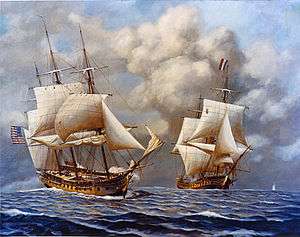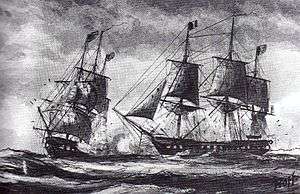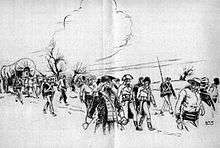Quasi-War
The Quasi-War (French: Quasi-guerre) was an undeclared war fought almost entirely at sea between the United States and France from 1798 to 1800, which broke out during the beginning of John Adams's presidency. After the French Monarchy was abolished in September 1792, the United States refused to continue repaying its large debt to France, which had supported the U.S. during its own War for Independence. The U.S. claimed that the debt had been owed to a previous regime. France was also outraged over the Jay Treaty and that the United States was actively trading with Britain, with whom France was at war. In response, France authorized privateers to conduct attacks on American shipping, seizing numerous merchant ships and ultimately leading the U.S. to retaliate.
| Quasi-War | |||||||
|---|---|---|---|---|---|---|---|
| Part of the War of the Second Coalition | |||||||
  Left: USS Constellation vs L'Insurgente; right: U.S. Marines from USS Constitution boarding and capturing French privateer Sandwich | |||||||
| |||||||
| Belligerents | |||||||
|
Co-belligerent: |
Co-belligerent: | ||||||
| Commanders and leaders | |||||||
|
|
| ||||||
| Strength | |||||||
|
A fleet of 54 including: 18 Frigates 4 Sloops 2 Brigs 3 Schooners 5,700 sailors and Marines 365 privateers |
Unknown fleet size Unknown number of sailors and Marines | ||||||
| Casualties and losses | |||||||
|
American:
After U.S. military involvement:
British:
|
French:
Spanish:
| ||||||
The war was called "quasi" because it was undeclared. It involved two years of hostilities at sea, in which both navies and privateers attacked the other's shipping in the West Indies. Many of the battles involved famous naval officers such as Stephen Decatur, Silas Talbot and William Bainbridge. The unexpected fighting ability of the newly re-established U.S. Navy, which concentrated on attacking the French West Indian privateers, together with the growing weaknesses and final overthrow of the ruling French Directory, led the French foreign minister, Talleyrand, to reopen negotiations with the U.S. At the same time, Adams feuded with Alexander Hamilton over control of the Adams administration. Adams took sudden and unexpected action, rejecting the anti-French hawks in his own party and offering peace to France. In 1800 he sent William Vans Murray to France to negotiate peace; the Federalists cried betrayal. Hostilities ended with the signing of the Convention of 1800.[5]
Background
When the United States won its independence it no longer had Britain's protection and therefore had the task of protecting its own ships and interests at sea. There were few American ships capable of defending the American coastline while trying to protect its merchant ships at sea.[6] The Kingdom of France was a crucial ally of the United States in the American Revolutionary War. In March 1778, France signed a treaty of alliance with the rebelling colonists against Great Britain and had loaned the new Republic large sums of money. However, Louis XVI of France was deposed in September 1792. The monarchy was abolished.
In 1794 the American government reached an agreement with Great Britain in the Jay Treaty, which was ratified the following year. It resolved several points of contention between the United States and Britain that had lingered since the end of the American Revolution. The treaty encouraged bilateral trade and enabled expanded trade between the United States and Britain, stimulating the American economy. From 1794 to 1801, the value of American exports nearly tripled, from US$33 million to $94 million.[7] But the Jeffersonian Democratic-Republicans, who were pro-France, always denigrated the Jay Treaty.[8][7]
The United States declared neutrality in the conflict between Great Britain and revolutionary France; and Congress passed legislation for a trade deal with Great Britain. When the U.S. refused to continue repaying its debt, saying that the debt was owed to the previous government, not to the French First Republic, French outrage led to a series of responses. First, France authorized privateers to seize U.S. ships trading with Great Britain, and taking them back to port as prizes to be sold. Next, the French government refused to receive Charles Cotesworth Pinckney, the new U.S. Minister, when he arrived in Paris in December 1796, severing diplomatic relations.[7] In President John Adams's annual message to Congress at the close of 1797, he reported on France's refusal to negotiate a settlement and spoke of the need "to place our country in a suitable posture of defense".[9] Adams offered Washington a commission as lieutenant-general on July 4, 1798, and as commander-in-chief of the armies raised for service in that conflict.[10] In April 1798, President Adams informed Congress of the "XYZ Affair", in which French agents demanded a large bribe before engaging in substantive negotiations with United States diplomats.
Meanwhile, French privateers inflicted substantial losses on American shipping. On 21 February 1797, Secretary of State Timothy Pickering told Congress that during the previous eleven months, France had seized 316 U.S. merchant ships. French marauders cruised the length of the Atlantic seaboard virtually unopposed. The United States government had nothing to combat them, as it had abolished the navy at the end of the Revolutionary War, and its last warship was sold in 1785. The United States had only a flotilla of small Revenue-Marine cutters and a few neglected coastal forts.
Increased depredations by French privateers led to the government in 1798 establishing the Department of Navy and the U.S. Marine Corps to defend the expanding American merchant fleet. Benjamin Stoddert was appointed as Secretary of Navy. Congress authorized the president to acquire, arm, and man not more than twelve ships of up to twenty-two guns each. Several merchantmen were immediately purchased and refitted as ships of war.[11]
Congress rescinded the treaties with France on 7 July 1798,[12] and two days later Congress passed legislation authorizing the use of military force against French warships in American waters.
On 16 July, Congress appropriated funds "to build and equip the three remaining frigates begun under the Act of 1794": USS Congress, launched at Portsmouth, New Hampshire, on 15 August 1799; USS Chesapeake, launched at Gosport Shipyard, Virginia,[lower-alpha 1] on 2 December 1799; and USS President, launched at New York, New York, on 10 April 1800. To make the most effective use of his limited resources, Secretary Stoddert established a policy that American forces would be concentrated on attacks against French forces in the Caribbean, where France still had colonies, though at times he had to grant merchant ships' requests for escorts.
Naval engagements

The naval engagements of the Quasi-War primarily consisted of single-ship actions off the coast of the United States and in the Caribbean. At the beginning of the conflict, the U.S. Navy operated with a battle fleet of about 25 vessels, which patrolled the southern coast of the United States and throughout the Caribbean hunting down French privateers. French privateers generally resisted, as did La Croyable, which was captured on 7 July 1798, by Delaware outside Egg Harbor, New Jersey.[13] On 20 November, a pair of French frigates, Insurgente and Volontaire, captured the schooner USS Retaliation, commanded by Lieutenant William Bainbridge; Retaliation would be recaptured on 28 June 1799.
On 9 February 1799, the frigate Constellation captured the French Navy's frigate L'Insurgente and severely damaged the frigate La Vengeance, largely due to Captain Thomas Truxtun's focus on crew training. By 1 July, under the command of Stephen Decatur, USS United States had been refitted and repaired and embarked on its mission to patrol the South Atlantic coast and West Indies in search of French ships which were preying on American merchant vessels.[14]
On 1 January 1800, a convoy of American merchant ships and their escort, United States naval schooner USS Experiment, engaged a squadron of armed barges manned by French-allied Haitians known as picaroons off the coast of present-day Haiti. On 1 February, the American frigate USS Constellation unsuccessfully tried to capture the French frigate La Vengeance off the coast of Saint Kitts. In early May, Captain Silas Talbot organized a naval expedition to Puerto Plata on the island of Hispaniola in order to harass French shipping. The Talbot's expedition captured the Spanish coastal fort at Puerto Plata and a French corvette. Following the French invasion of Curaçao in July, the American sloops USS Patapsco and USS Merrimack began a blockade of the island in September that led to a French withdrawal. On 12 October, the frigate Boston captured the corvette Le Berceau. On 25 October, the USS Enterprise defeated the French brig Flambeau near the island of Dominica in the Caribbean Sea. Enterprise also captured eight privateers and freed eleven U.S. merchant ships from captivity, while Experiment captured the French privateers Deux Amis and Diane and liberated numerous American merchant ships.
American naval losses may have been light, but the French had successfully seized many American merchant ships by the war's end in 1800 – more than 2,000, according to one source.[16][7]

Role of the American Revenue-Marine
Revenue cutters in the service of the American Revenue-Marine also took part in the conflict. The cutter USRC Pickering, commanded by Edward Preble, made two cruises to the West Indies and captured ten prizes. Preble turned command of Pickering over to Benjamin Hillar, who captured the much larger and more heavily armed French privateer l'Egypte Conquise after a nine-hour battle. In September 1800, Hillar, Pickering, and her entire crew were lost at sea in a storm. Preble next commanded the frigate USS Essex, which he sailed around Cape Horn into the Pacific to protect U.S. merchantmen in the East Indies. He recaptured several U.S. ships that had been seized by French privateers.[17][18][19]
Involvement of the Royal Navy
Although they were fighting the same enemy, the Royal Navy and the United States Navy did not cooperate operationally or share operational plans. There were no mutual understandings about deployment between their forces. However, the British sold naval stores and munitions to the U.S. government, and the two navies shared a signal system so they could recognize the other's warships at sea and allowed their merchantmen to join each other's convoys for safety.
Conclusion of hostilities
By late 1800, the United States Navy and the Royal Navy, combined with a more conciliatory diplomatic stance by the government of First Consul Napoleon Bonaparte, had reduced the activity of the French privateers and warships. The Convention of 1800, signed on 30 September, ended the Quasi-War. It affirmed the rights of Americans as neutrals upon the sea and abrogated the alliance with France of 1778. However, it failed to provide compensation for the $20 million "French Spoliation Claims" of the United States. The agreement between the two nations implicitly ensured that the United States would remain neutral toward France in the wars of Napoleon and ended the "entangling" French alliance.[20] This alliance had been viable only between 1778 and 1783.[21]
See also
Notes
- now the Norfolk Naval Shipyard
References
- "Military history – The Quasi War". About.com.
- America's First Limited War, Lieutenant Colonel Gregory E. Fehlings, U.S. Army Reserve
- Clodfelter, M. (2017). Warfare and Armed Conflicts: A Statistical Encyclopedia of Casualty and Other Figures, 1492-2015 (4th ed.). Jefferson, North Carolina: McFarland. Pages 136-137.
- Lyon, 1940, pp. 305–333
- Waldo, 1821, pp. 30–31.
- Hickey, 2008, pp.67–77
- Jerald A. Combs, The Jay Treaty: Political Battleground of the Founding Fathers (1970).
- "First State of the Nation Address by President John Adams Philadelphia, PA, 22 November 1797". Archived from the original on 7 March 2012. Retrieved 28 December 2010.
- Kohn 1975, pp. 225–42; Grizzard 2002, p. 263.
- Williams, 2009, p. 25
- 1 Stat. 578 ch. 67
- Mooney, James L., ed. (November 1983). Dictionary of American Naval Fighting Ships. 6. Defense Dept., Navy, Naval History Division. p. 84. ISBN 978-0-16-002030-8. Retrieved 27 June 2011.
- Mackenzie, 1846, p. 40.
- Lieutenant Colonel Gregory E. Fehlings, "America’s First Limited War", Naval War College Review, Volume 53, Number 3, Summer 2000
- The United States Coast Guard The Coast Guard at War
- "USRCS Lost at Sea". Archived from the original on 28 July 2013. Retrieved 9 November 2008.
- Love 1992, p. 68
- E. Wilson Lyon, "The Franco-American Convention of 1800". Journal of Modern History 12.3 (1940): 305–333. online
- Deconde, Alexander DeConde, 1966, pp. 162–184
Bibliography
- Allen, Gardner Weld (1909). Our Naval War With France. Boston and New York: Houghton Mifflin. OCLC 1202325.
- Grizzard, Frank E. (2002). George Washington: A Biographical Companion. ABC-CLIO. ISBN 978-1-57607-082-6.CS1 maint: ref=harv (link)
- Harris, Thomas (1837). The life and services of Commodore William Bainbridge, United States navy.
Carey Lea & Blanchard, Philadelphia. p. 254. ISBN 0945726589. E'book2
- Hickey, Donald R. (2008). The Quasi-War: America's First Limited War, 1798–1801 (PDF). The Northern Mariner/le marin du nord, XVIII Nos. 3–4, July–October 2008.
- Knox, Dudley W., ed. (1939). Naval Documents related to the United States Wars with the Barbary Powers, Volume I. Washington: United States Government Printing Office. Retrieved 12 November 2018.
- Kohn, Richard H. (1975). Eagle and Sword: The Federalists and the Creation of the Military Establishment in America, 1783–1802. Free Press. pp. 225–42. ISBN 978-0-02-917551-4.CS1 maint: ref=harv (link)
- Lyon, E. Wilson (September 1940). "The Franco-American Convention of 1800". The Journal of Modern History. The University of Chicago Press. 12 (3): 305–333. doi:10.1086/236487. JSTOR 1874761.
- Jennings, John (1966). Tattered Ensign The Story of America's Most Famous Fighting Frigate, U.S.S. Constitution. Thomas Y. Crowell. OCLC 1291484.
- Mackenzie, Alexander Slidell (1846). Life of Stephen Decatur: A Commodore in the Navy of the United States. C. C. Little and J. Brown. pp. 443.
- de Langlais, Tugdual, Marie-Etienne Peltier, Capitaine corsaire de la République, Éd. Coiffard, 2017, 240 p. (ISBN 9782919339471).
- Waldo, Samuel Putnam (1821). The Life and Character of Stephen Decatur. P. B. Goodsell, Hartford, Conn.
- Williams, Greg H. (2009). The French Assault on American Shipping, 1793–1813: A History and Comprehensive Record of Merchant Marine Losses. McFarland Publishers. ISBN 9780786454075.
Further reading
- Bowman, Albert Hall. The struggle for neutrality: Franco-American diplomacy during the Federalist era (1974), online free
- Daughan, George C. (2008). If By Sea: The Forging of the American Navy – From the Revolution to the War of 1812. Philadelphia: Basic Books. ISBN 978-0-465-01607-5.
- DeConde, Alexander (1966). The Quasi-War: The Politics and Diplomacy of the Undeclared War with France, 1797–1801. Charles Scribner's Sons.
- Palmer, Michael . (1987). Stoddert's War: Naval Operations During the Quasi War With France 1798-1801. University of South Carolina Press. ISBN 978-0-8724-9499-2.
- Leiner, Frederick C. (1999). Millions for Defense: The Subscription Warships of 1798. Annapolis: US Naval Institute Press. ISBN 978-1-55750-508-8.
- Love, Robert (1992). History of the U.S. Navy Volume One 1775–1941. Harrisburg PA: Stackpole Books. ISBN 978-0-8117-1862-2.
- Nash, Howard Pervear. The forgotten wars: the role of the US Navy in the quasi war with France and the Barbary Wars 1798–1805 (AS Barnes, 1968)
- Palmer, Michael A. Stoddert's war: Naval operations during the quasi-war with France, 1798–1801. Naval Institute Press, 1999
- Toll, Ian W. (2006). Six Frigates: The Epic History of the Founding of The U.S. Navy. New York: W.W. Norton. ISBN 978-0-393-05847-5.
- Unger, Harlow (2005). The French War Against America: How a Trusted Ally Betrayed Washington and the Founding Fathers. Hoboken NJ: John Wiley & Sons, Inc. ISBN 978-0-471-65113-0.
- Williams, Greg H. (2009). The French Assault on American Shipping, 1793–1813: A History and Comprehensive Record of Merchant Marine Losses. McFarland. ISBN 9780786454075.
External links
- "Selected Bibliography of The Quasi-War with France" compiled by the United States Army Center of Military History
- U.S. Department of State "The XYZ Affair and the Quasi-War with France, 1798–1800"
- "U.S. treaties and federal legal documents re 'Quasi-War with France 1791–1800'", compiled by the Lillian Goldman Law Library of Yale Law School